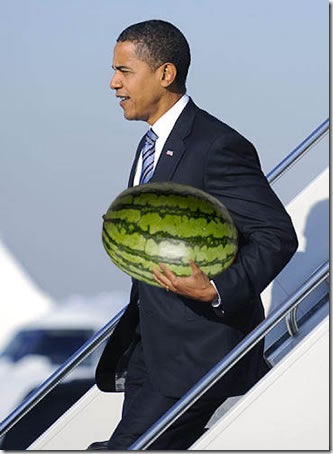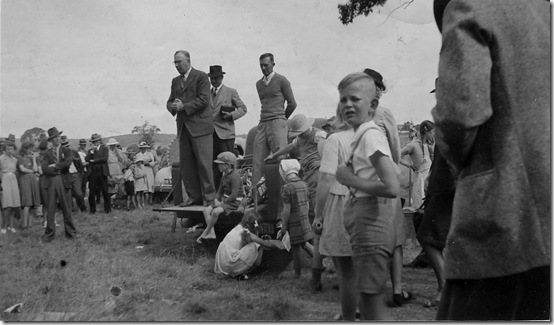It was raining when I got up this morning. These were some of the wettest March and April months in Sydney for a long time, and I'm sick of it. I am out of clean clothes, I am sick of it, and I wish it would go away for a little while!
I did end up watching the Royal Wedding last night and enjoyed it, although the little Britishness of the BBC coverage (the ABC took the BBC feed straight) ended by annoying me. Unlike past coverage, there was little recognition that the wedding was also important to others.
After the wedding I spent a little time looking at the reactions, although my continued problems with Twitter reception made this difficult. I noticed one plaintive comment, I think that it was actually on Facebook: "I don't understand why so many people care." That got me musing on memory and nostalgia.
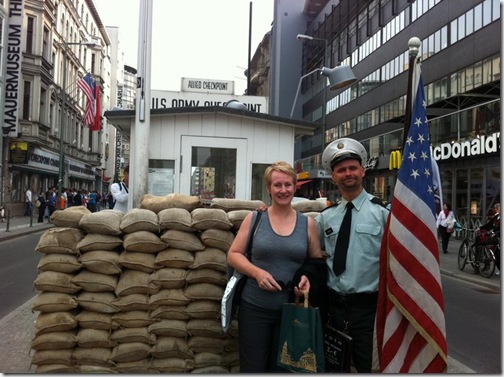 I have mentioned before that my wife is in Europe visiting eldest daughter. This is a photo of Dee at Checkpoint Charlie in Berlin.
I have mentioned before that my wife is in Europe visiting eldest daughter. This is a photo of Dee at Checkpoint Charlie in Berlin.
Dee grew up in the cold war period and acquired an addiction for spy novels, films and TV series set in that period. So in Berlin, she wanted to visit scenes and localities made familiar by her reading and watching.
The Berlin Wall fell in 1989. That's quite recent, yet already the events of the Cold War period are fading from memory. Len Deighton's novels may survive, but it is hard to re-capture the darkness and grittiness of the period for younger audiences increasingly lacking a visual and emotional context.
In 1979 I went to London and the UK for the first time. As I have said before, I come from the generation of young Australians that first really discovered Asia. My first three month overseas trip was to Asia, almost fourteen years before I finally made it to the UK. I was comfortable in my skin as an Australian and simply took it for granted.
One of the reasons why I got quite cranky at one point with the Whitlam Government is that what I saw as its obsessive focus on "being Australian" and "what it meant to be Australian' actually appeared to challenge or even discredit my own fully formed sense of national identity. I felt that this was the national and political equivalent of the cultural cringe that I had always so strongly objected to.
Given all this, I was quite surprised at the resonance I felt when I arrived in London. Upon reflection, it could hardly have been otherwise.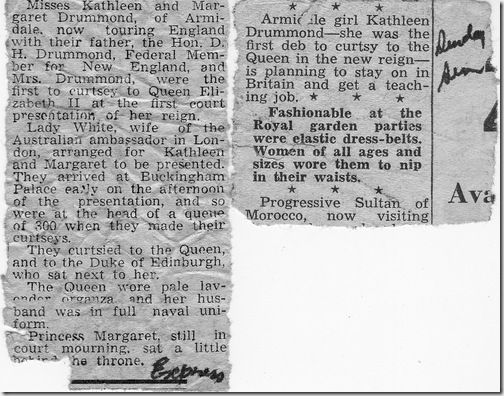
The next reproduction are two newspaper clippings from Cousin Jamie's collection about the presentation of my Aunts to the new Queen. There were strong and multi-layered family connections between Australia, the UK and other parts of the now fading Commonwealth and Empire.
I have written a little on this in exploring one aspect of Australian and indeed broader history, the nature of Imperial families. By this, I don't mean the very grand, but the nature of families and family connections that spanned countries within the Commonwealth and Empire.
There is remarkably little writing on this. In the Australian case, we tend to focus on those who came here and then their life after they arrived. The context has been cut off. In the case of my own not very large family, we had immediate relatives or connections in the Australia, the UK, New Zealand, Canada, India, Hong Kong and the US. One aunt was serving in Malaya with the Red Cross (the Emergency was on) and had fallen in love with the country. One of her closest friends married David Marshall who would become Singapore's first Chief Minister.
The point of this story is simple to explain some of the emotional resonance that I felt on arriving in London. But beyond this was the visual, the recognition of things made so familiar by books and films. As the family and political links across the old Empire and Commonwealth have reduced, as the visual material has declined and lost emotional context, so has understanding and interest. I can understand someone asking why all the fuss, although it might pull me up short because I can't disengage my own feelings.
One of the great tribal divisions in Australia, one deeply embedded in the history of the United Kingdom and Ireland and in the broader sweep of European history, has been that between the Irish Catholic minority and the broader generally Anglican/Protestant majority. This division overlapped with a second, that between Labor and Capital, the rise of unions and the Labor Party.
To be Irish was to be Roman Catholic and Labor. You were also more likely to be anti-British. To be Labor was not necessarily to be either Irish or Roman Catholic, for there was a strong secular even anti-religious thread, as well as Protestant British influences. However, the Irish Catholic influence was strong, Further, within Labor and union ranks there was a strong rejection by many of what were seen as the trappings of class and of Imperial pompery.
By contrast, to be Anglican or Protestant (sometimes the two can be equated, other times not) you were more likely to pro-Britain, pro-Empire, deeply suspicious of the popery that had threatened England in the past. Religious divides ran very deep because there were reinforced by other tribal conflicts, as well as the desire of the Irish Catholic hierarchy to retain their power over the Church.
Of course, this is a simplification. However, if you trace through the threads in Australian thought as well as politics, you can see how these divides have affected aspects of Australian life and thought in a way that continues today.
You can also see why there might be conflicts between my own perceptions and those of a Whitlam Government strongly influenced by thoughts and arguments on the other side of the tribal divide. Historically, this marked the start of what came to be called the Australian history wars. It also energised the republican movement, moving it from peripheral towards the main stream.
The now famous Whitlam campaign slogan, It's Time, accurately caught the mood. It captured the mood for change, with the Whitlam campaign gaining great support among actors, writers, journalists, film makers, painters and university students and staff.
Even though the Governor General did not consult the Queen and acted presidentially in dismissing the Whitlam Government, something that Mr Whitlam himself explicitly recognised, there was a sense of betrayal that translated in part to a campaign for a republic, for a change to the system of Government. In an interview, I do not have a link, former PM Keating made it quite clear that he was , in Mr Whitlam's 1975 term, maintaining the rage. There was unfinished business.
It is now thirty-five years since the Whitlam Government was dismissed, and that period too has become wrapped in nostalgia. We can see this in the success of Paper Giants: the birth of Cleo. This was not just good television in a general sense, but with its inclusion of archival footage and its approach, it brought back an era. However, here there is another problem.
The Northern Ireland Peace Accords were signed on 10 April 1998, thirteen years ago. I watched the live coverage on the BBC because of its historical significance.
By then, the previously bitter sectarian divides in Australia had largely ended. The political parties, while to some extent still tribal, had professionalised. The union movement was in decline, while the Catholic Church and indeed the churches in general had lost their place. Many of the core ideas underpinning Australian life such as the old social contract had vanished. The class struggle was over, replaced by competition and the market. Now the Peace Accords took Ireland of the table.
Just as I had earlier seen some of the things that had formed me stripped away, now the very underpinnings on the other side had been removed. My nostalgia for elements of Empire and Commonwealth is pretty much equivalent to the nostalgia by some people for Its Time and the Whitlam years. Mind you, I share some of that nostalgia because I too remember other elements of the 1960s and 1970s.
Change makes for strange bedfellows.
I remember my father and mother-in-law coming to dinner at my aunt and uncle's place for the first time. There was a degree of discomfort because Labor, Irish and Catholic was meeting National (Country) Party and Protestant. Yet I get on remarkably well with my mother-in-law because we have so much in common. I find that in many ways I am closer to the old time Labor Party than I am to the modern Liberal Party. Tribal enemies maybe, but shared values still.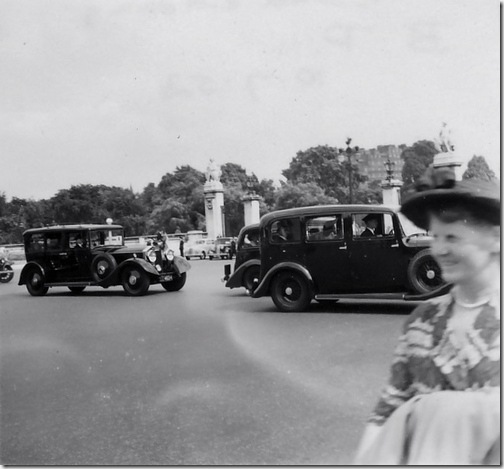
Since this post is in part a bit of a nostalgia trip, the photo shows my grandparents (car right) entering Buckingham Place 10 July 1952. This was just over a month after the coronation.
In trying to describe the fundamental difference between the Aboriginal world view and that of the European settlers arriving on their land, I said that to the Aborigines the present was part of a living past. To the Europeans, the present was a step to a still to be defined future. I think that the second is still true, at least so far as Australia is concerned.
I have complained about Australia's loss of its past from time to time, and indeed in my writing I have tried to bring some of that past back to life. Yet the Australian view is not always a bad thing.
I remember when I first arrived in Europe I actually came to find the sense of history oppressive. I felt that Australia was in a better position because we were less constrained by our past. However, there is a price in this, for none of us can assume that the views we hold dear or even to be self-evident will survive into the medium term.
We live in a world now where processes, policies and technology constantly reshape. When I was born, there was an apparent historical continuity. This vanished during the tip decade of the 1970s. Since then, change has accelerated, while the life expectancy of social structures and attitudes has declined.
This, I guess, is the real point of this muse and of the examples that I have used.



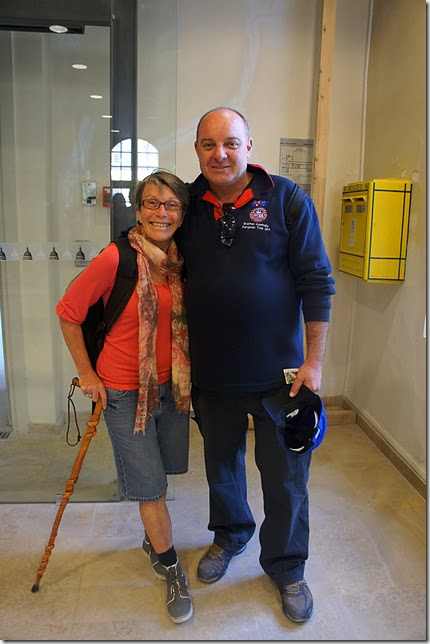
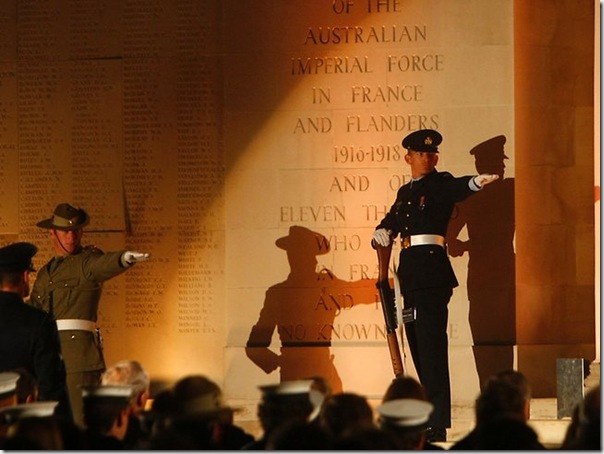
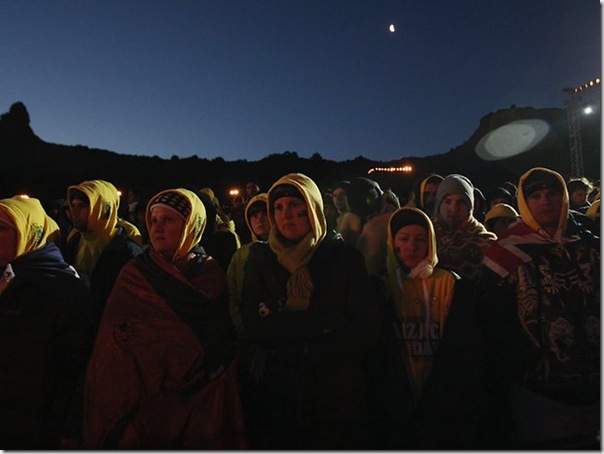
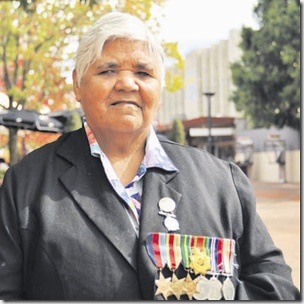
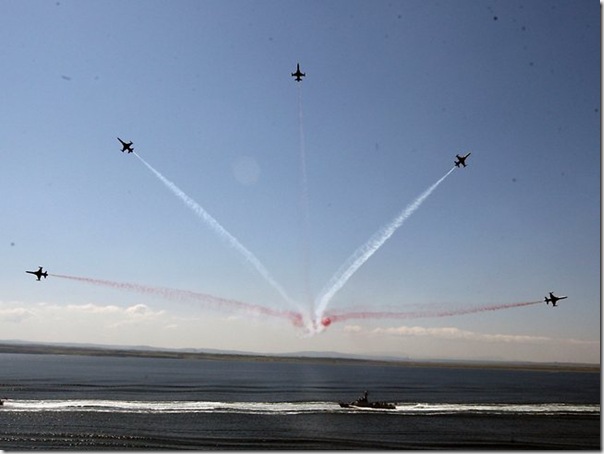
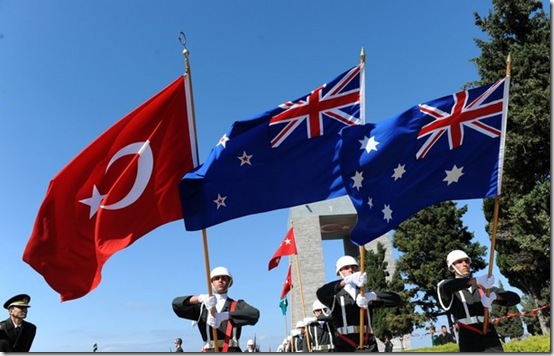
![Vietnamese refugees 1979[4]](http://lh6.ggpht.com/_VqdNmb7Wc_I/TbT1hvaX1oI/AAAAAAAAEKM/5HEd-00h6C8/Vietnamese%20refugees%201979%5B4%5D_thumb%5B8%5D.jpg?imgmax=800)
